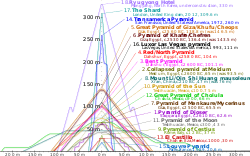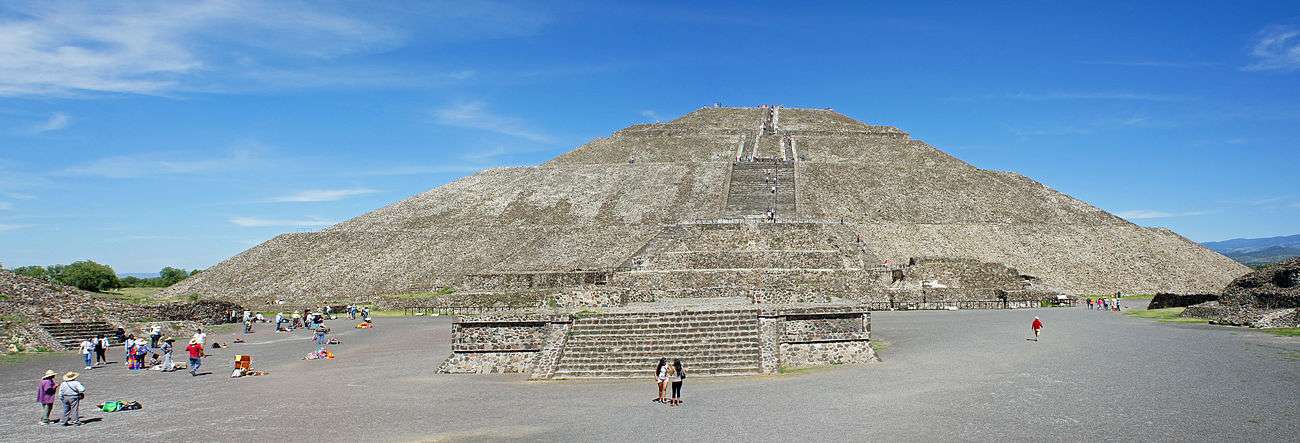Pyramid of the Sun
|
Front view of the Pyramid of the Sun | |
| Location | Mexico State |
|---|---|
| Region | Mesoamerica |
| Type | Pyramid, Temple |
| Part of | Teotihuacan |
| Length | 220 meters (720 feet)[1] |
| Width | 230 meters (760 feet)[2] |
| Volume | 1,184,828.3 cubic meters (41,841,817 cubic feet) |
| Height | 65.5 meters (216 feet)[3] |
| History | |
| Founded | 200 CE[4] |
| Abandoned | 750 CE[5] |
| Periods | Mesoamerican classic |
| Cultures | Teotihuacan |
| Site notes | |
| Condition | Protect by UNESCO |
| Ownership | Cultural heritage |
| Management | World Heritage Committee |
| Public access | Yes |
| Third largest ancient pyramid in the world, the second largest is the Pyramid of Giza and the largest is the Great Pyramid of Cholula which is 90 kilometers away | |
The Pyramid of the Sun is the largest building in Teotihuacan, believed to have been constructed about 200 CE,[6] and one of the largest in Mesoamerica. Found along the Avenue of the Dead, in between the Pyramid of the Moon and the Ciudadela, and in the shadow of the massive mountain Cerro Gordo, the pyramid is part of a large complex in the heart of the city.
History


The name Pyramid of the Sun comes from the Aztecs, who visited the city of Teotihuacan centuries after it was abandoned; the name given to the pyramid by the Teotihuacanos is unknown. It was constructed in two phases. The first construction stage, around 100 CE, brought the pyramid to nearly the size it is today. The second round of construction resulted in its completed size of 224.942 meters (738 feet) across and 75 meters (246 feet) high, making it the third largest pyramid in the world,[7] though still just over half the height of the Great Pyramid of Giza (146 metres). The second phase also saw the construction of an altar atop of the pyramid, which has not survived into modern times. The Adosada platform was added to the pyramid in the early third century, at around the same time that the Ciudadela and Temple of the Feathered Serpent, Teotihuacan Pyramid of the Feathered Serpent were constructed.
Over the structure the ancient Teotihuacanos finished their pyramid with lime plaster imported from surrounding areas, on which they painted brilliantly colored murals. While the pyramid has endured for centuries, the paint and plaster have not and are no longer visible. Jaguar heads and paws, stars, and snake rattles are among the few images associated with the pyramids.
It is thought that the pyramid venerated a deity within Teotihuacan society, however, little evidence exists to support this hypothesis. The destruction of the temple on top of the pyramid, by both deliberate and natural forces prior to the archaeological study of the site, has so far prevented identification of the pyramid with any particular deity.
Structure measurements, location and orientation
| Dimension[8] | Value |
|---|---|
| Height | 71.17 metres or 233.5 feet |
| Base perimeter | 794.79 square metres or 8,555.0 square feet |
| Side | 223.48 metres or 733.2 feet |
| 1/2 side | 111.74 metres or 366.6 feet |
| Angle of slope | 32.494 degrees |
| Lateral surface area | 59,213.68 square metres or 637,370.7 square feet (assumes perfect square base and smooth faces) |
| Volume | 1,184,828.31 cubic metres or 41,841,817 cubic feet (assumes perfect square base and smooth faces) |

The orientation of the structure may hold some anthropological significance. The pyramid is oriented slightly northwest of the horizon point of the setting sun on two days a year, August 12 and April 29, which are about one divinatory calendar year apart for the Teotihuacanos. The day of August 12 is significant because it would have marked the date of the beginning of the present era and the initial day of the Maya long-count calendar. In addition, many important astronomical events can be viewed from the location of the pyramid that are important in terms of both agriculture and belief systems of the ancient society.
The pyramid was built over a man-made tunnel leading to a "cave" located six metres down beneath the centre of the structure. Originally this was believed to be a naturally formed lava tube cave and interpreted as possibly the place of Chicomoztoc, the place of human origin according to Nahua legends. More recent excavations have suggested that the space is man-made and could have served as a royal tomb.[9] Recently scientists have used muon detectors to try to find other chambers within the interior of the pyramid, but substantial looting has prevented the discovery of a function for the chambers in Teotihuacan society.
Recovered artifacts

Only a few caches of artifacts have been found in and around the pyramid. Obsidian arrowheads and human figurines have been discovered inside the pyramid and similar objects have been found at the nearby Pyramid of the Moon and Pyramid of the Feathered Serpent in the Ciudadela. These objects may have represented sacrificial victims. A unique historical artifact discovered near the foot of the pyramid at the end of the nineteenth century was the Teotihuacan Ocelot, which is now in the British Museum's collection.[10] In addition, burial sites of children have been found in excavations at the corners of the pyramid. It is believed that these burials were part of a sacrificial ritual dedicating the building of the pyramid.
See also
References
- ↑ "Teotihuacán." Britannica School. Encyclopædia Britannica, Inc., 2014. Web. 9 Dec. 2014.
- ↑ "Teotihuacán." Britannica School. Encyclopædia Britannica, Inc., 2014. Web. 9 Dec. 2014.
- ↑ "Teotihuacán." Britannica School. Encyclopædia Britannica, Inc., 2014. Web. 9 Dec. 2014.
- ↑ "Teotihuacán." Early Civilizations in the Americas Reference Library. Ed. Sonia G. Benson, Sarah Hermsen, and Deborah J. Baker. Vol. 2: Almanac, Vol. 2. Detroit: UXL, 2005. 315-332. Student Resources in Context. Web. 14 Dec. 2014.
- ↑ "Teotihuacán." Britannica School. Encyclopædia Britannica, Inc., 2014. Web. 9 Dec. 2014.
- ↑ Teotihuacan: Pyramids of the Sun and the Moon, Heilbrunn Timeline of Art History, The Metropolitan Museum of Art, retrieved October 29, 2016
- ↑ Aston, Michael; Tim Taylor (1998). Atlas of Archaeology. Dorling Kindersley. p. 43. ISBN 978-0-7894-3189-9.
- ↑ Reynolds, Mark (1999). "A Comparative Geometric Analysis of the Heights and Bases of the Great Pyramid of Khufu and the Pyramid of the Sun at Teotihuacan". Nexus Network Journal. Kim Williams Books. 1: 87–92. Archived from the original on 11 August 2006.
- ↑ Šprajc, Ivan (2000). "Astronomical Alignments at Teotihuacan, Mexico". Latin American Antiquity. 11 (4). p. 410.
- ↑ British Museum Highlights
Further reading
| Wikimedia Commons has media related to Pirámide del Sol. |
- Evans, Susan Toby (2004). Ancient Mexico and Central America.
- Gwin, Peter (Feb 2005). "Seeing Through Walls". National Geographic.
- Šprajc, Ivan (2000). "Astronomical Alignments at Teotihuacan, Mexico". Latin American Antiquity. 11 (4). pp. 403–415.
- Sugiyama, Saburo (2005). "Governance and Polity at Classic Teotihuacan". Mesoamerican Archaeology.
Coordinates: 19°41′33″N 98°50′38″W / 19.6925°N 98.8438°W
